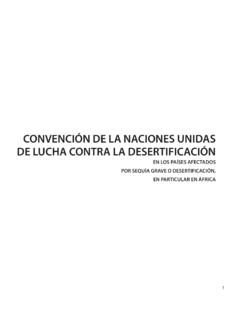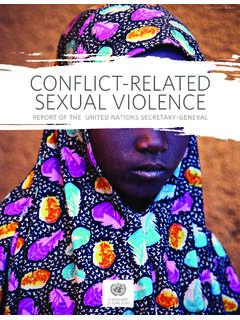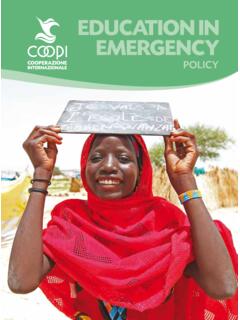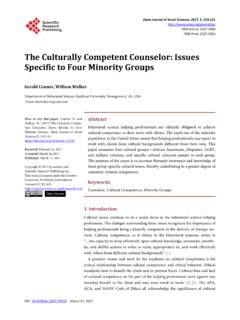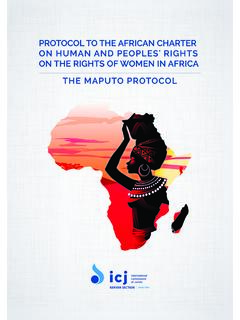Transcription of DESERTIFICATION - UNCCD
1 DESERTIFICATION THE INVISIBLE FRONTLINE To fight or to flee? These are the stark choices Maria, a single mother from the Bangalala midlands of Tanzania, faces repeatedly. Her choice, along with those of families like hers, are felt all over the world. After the rains failed for a few years, some neighbors claimed our trees were drawing too much water from the ground. We cut them down. Our harvests fell. My mother closed her stall at the local market. That is when my father and I moved from the midlands to the Ruvu Mferejini river valley. My brother quit school to help the family. He went to find work but he does not earn enough. My mother stayed in Bangalala so that my daughter could go to school because there are no schools in the valley. But where we moved to, my crop also failed last year. That is why early this year I moved yet again, but I left my father behind. I hope to farm here much longer, as I am sure the people I left behind with my father will have to move too.
2 But when will this moving end? I cannot afford it anymore. This is not an isolated case. Maria is in the same situation that women in Darfur, Mali, Chad or Afghanistan were in before local conflicts over water or land turned into civil wars, sexual violence or genocide. Nor is this situation unique to sub-Saharan Africa where half a billion inhabitants are rural, a majority lives off the land and DESERTIFICATION is a constant threat to their livelihoods. More than billion people in the world depend on degrading land, and 74% of them, like Maria, are poor. Under the United Nations Convention to Combat DESERTIFICATION ( UNCCD ), the international legal framework for tackling DESERTIFICATION , land degradation and drought, 169 of its 194 Parties have declared they are affected by is a silent, invisible crisis that is destabilizing communities on a global scale. As the effects of climate change undermine livelihoods, inter-ethnic clashes are breaking out within and across states and fragile states are turning to militarization to control the situation.
3 The effects of DESERTIFICATION are increasingly felt globally as victims turn into refugees, internally displaced people and forced migrants or they turn to radicalization, extremism or resource-driven wars for survival. If we are to restore peace, security and international stability in a context where changing weather events are threatening the livelihoods of more and more people, survival options are declining and state capacities are overburdened, then more should be done to combat DESERTIFICATION , reverse land degradation and mitigate the effects of drought. Otherwise, many small-scale farmers and poor, land-dependent communities face two choices: fight or OPTIONS, GLOBAL CONSEQUENCES111 FOOD (IN)SECURITY - FARMING OURSELVES INTO EXTINCTIONIn 2008, food insecurity triggered riots in over 30 countries. But it is rural communities like those of Bangalala, who depend on rainfed agriculture that contribute to global food security.
4 The livelihoods of over 2 billion people worldwide depend on 500 million small-scale farmers. Drylands, which make up nearly 34% of the land mass and are a major source of food security especially for the poor, are being degraded day-by-day. How shall we meet the growing food demand and increase food production by 70% by 2050, when productive land is declining and we do not act on DESERTIFICATION and its related climate challenges? A total of 842 million people, or about one in eight people in the world, were estimated to be suffering from chronic hunger in 2011 2013. 12 million hectares of productive land become barren every year due to DESERTIFICATION and drought alone, which is a lost opportunity to produce 20 million tons of grain Agricultural yields could fall by up to 50% in some African countries if production practices are not changed Poor people spend between 50% and 80% of their income on food2 Land degradation is a problem that affects all regions, not only the drylands and developing countries.
5 About one third of all agricultural land is either highly or moderately degraded. Drylands are more vulnerable to natural and human destruction due to the small water containment in soil. Status and trends in global land degradationThe land productive capacity dynamics map shows 5 classes indicating areas of negative or positive change or stability of land productive capacity. It can be interpreted as indicator of change or stability of the land s apparent capacity to sustain the dynamic equilibrium of primary productivity in the given 15 years observation period (1999-2013).3 Early sings of declineDecreasingStable, not stressedStable, but stressedIncreasing JRC, 2014 Land system productive capacity dynamics (1999-2013)WATER (IN)SECURITY WATER SCARCITY TRIGGERS CONFLICTSThe increase in droughts and flash floods that are stronger, more frequent and widespread is destroying the land the Earth s main fresh water store. Droughts kill more people than any other single weather-related catastrophe and conflicts among communities over water scarcity are gathering pace.
6 From the Bangalala midlands to Lake Turkana and Darfur, from Lake Chad to the northern parts of Mali, Niger, Chad and the Central African Republic, communities are migrating and being displaced as they search for scarce water resources. Without restoring degraded land and securing it from further degradation, we cannot save the land from the impacts of climate change, replenish underground sources to meet present and future water demands, diffuse ethnic tensions or reverse migration flows. Over 1 billion people today have no access to water, and demand will increase by 30% by 2030 By 2025, up to billion people worldwide may be living in areas subject to periods of intense water scarcity, which may displace as many as 700 million people by 2030 Collectively, women from Sub-Saharan Africa spend about 40 billion hours a year collecting water Between 1991 and 2000 over 665,000 people died in 2,557 natural disasters, 90% of which were water-related events Thirty-four of the 37 countries presumed to be at risk of war due to the absence of trans-boundary water resources cooperation claim to be affected by DESERTIFICATION and land degradation Only 3 countries in the world have a national drought policy4 Lake Chad - decrease in area 1963, 1973, 1987, 1997 and 2001 Aral Sea - decrease in area 1960, 1990, 2000.
7 And 2010 The livelihoods of the inhabitants in the Lake Chad region, whose economic means depend mostly on agriculture and fishery, are under threat as the lake shrinks. The degradation of the land through deforestation and inappropriate land management, which is compounded by recurrent severe droughts, has led to declining ground water supplies to the and the construction of a large-scale network of canals and levees are depleting the Aral Sea water resources through infiltration and evaporation, degrading soils and vegetation, expanding secondary salinization, and reducing agricultural efficiency in oases. 5 CLIMATE CHANGING THE FACE OF THE EARTH CHANGES HUMANITYAs the climate changes, so is the face of the Earth, and with devastating effects on the lives of those who depend on the land. Food-production zones are shifting, crops are failing, livestock are dying and ponds, lakes, rivers and underground water sources are drying up.
8 In many degraded agricultural areas, as climate change combines with pre-existing challenges it is compounding the situation and pushing people that depend on farming, pastoralism and other natural resources into forced migrants. Poor rural households that depend on rainfed agriculture are most vulnerable to drought because they cannot absorb the losses. Droughts have led to migration, conflict or cessation in the past, in countries such as India, Bangladesh, Mauritania, Senegal, Morocco and Eritrea. Without a proper adaptation scenario, the prospect of conflict and environmentally forced migration will grow as the soil s water content falls and the land becomes less and less productive. From 1900-2005, precipitation declined in the Sahel, the Mediterranean region, southern Africa and parts of southern Asia The area affected by drought has increased since the 1970s, with more intense and longer droughts observed over wider areas since then, particularly in the tropics and sub-tropics From 1950-1980 10-14% of the land mass was classified as dry, which rose to between 25-30% between 2000 and 2010 The average river run-off and water availability is projected to decrease by 10-30% over some dry regions, including the dry tropics Climatic stresses account for of all stresses on land degradation in Africa Seasonal temperatures in the Sahel have risen by degrees Celsius, while the incidences of drought and erratic rainfall have increased over the last 40 years 6It is estimated that 135 million people are at risk of being displaced by DESERTIFICATION .
9 The problem is most severe in sub-Saharan Africa, particularly in the Sahel and the Horn of Africa. For poor people, migration is a complex and costly venture. Often, it is the last option in the bid to survive, but many poor people have little choice but to flee their lands. Losing productive land is driving people to make risky life choices. In rural areas where people depend on scarce productive land resources, land degradation is a driver of forced migration. With livelihoods coming under tremendous pressure, people like Maria with few options for survival can feel trapped. Unless we change the way we manage our land, in the next 30 years we may leave a billion or more vulnerable poor people with little choice but to fight or flee. An estimated 42% of households intensify their seasonal mobility in the event of poor harvests, while 17% migrate when there is crop destruction and 13% leave in the case of strong climatic events such as extreme droughts By 2020 an estimated 60 million people could move from the desertified areas of sub-Saharan Africa towards North Africa and Europe By 2050, 200 million people may be permanently displaced environmental migrants Decisions to migrate may be influenced by access to land, or the lack thereof, while forced migration almost invariably raises a multitude of land and property issues in the destination places and, further down the line, in the places of origin when the time for return has come.
10 [Laura Thompson, Deputy Director-General, International Organization for Migration]MIGRATION FIGHT OR FLEE77 NATIONAL SECURITY BREAKING DOWNMany of the intrastate conflicts taking place today are linked to the control and allocation of natural resources by states. The exposure of more and more poor people to water scarcity and hunger opens the door to the failure of fragile states and regional conflicts . Economic growth, development and poverty eradication are the building blocks for lasting peace and national security. Agriculture is a key driver of these processes for most developing nations, but many are losing crucial Agricultural Gross Domestic Product (AGDP) through land degradation. Without rights to land, however, people like Maria have little incentive to manage the land and other natural resources sustainably. Granting users the rights to own and use the resources they depend on can reverse trends, pull the poor out of poverty and create the conditions to build peace and a lasting security.
